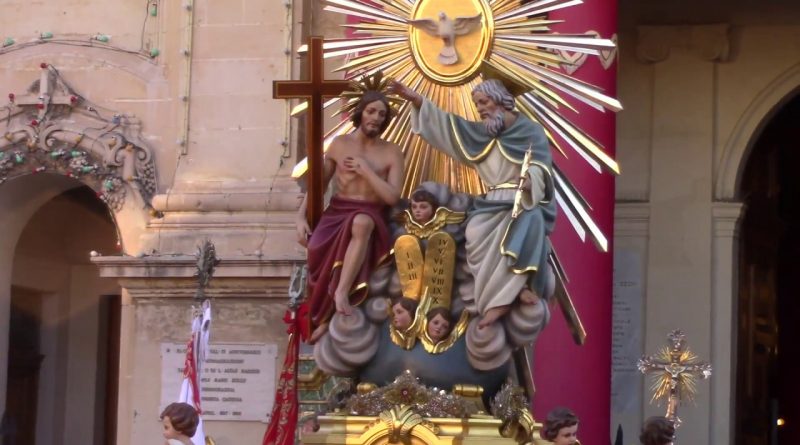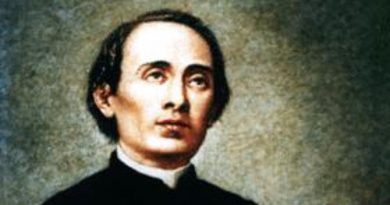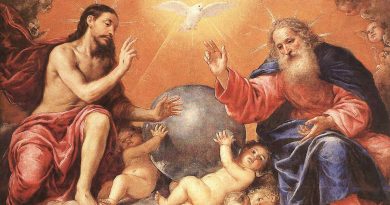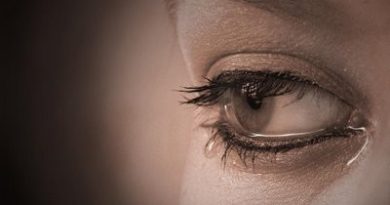The panegyric of the Holy Trinity at Marsa Parish Church 2021
This year 2021, dominated as it was by the coronavirus pandemic, we, as Parish dedicated to the Holy Trinity, could not celebrate this foundational feast of our faith as we should. However, the liturgical festivities were carried out as usual.
Personally speaking, this year for me has been of great grace simply because I had the joy of letting the Holy Spirit weaving the panegyric to the Most Holy Trinity. First of all, and after thanking and praising the Holy Trinity of Father, Son and Holy Spirit and the most powerful intercession of Mary, the Mother of God and our Mother, I want to thank wholeheartedly our dear parish priest, Fr Domnic Mangani OFM Cap, who offerred me this very special occasion to do so! To him go my sincere and fraternal thanksgiving!
The panegyric kicked off by a small poem the Holy Spirit gave me about our sacristan Mr Dione Cefai. His constant encouragement in my preparation for this panegyric made me alot of good. Then, spontaneously, came into my mind and heart a very sweet prayer taught to me by my childhood catechist, Mr Victor Floridia. As a nine-year-old boy who was passionate for the Christian Catholic faith, Mr Floridia taught us a very insightful manner of how to pray the sign of the Cross. In the name of the Father who created me, the Son who saved me and the Holy Spirit who sanctifies me.
The first phrase of the Cross: In the name of the Father who created me. With how much love and vigour does the Bible support such a claim. The Book of Genesis tells us: In the beginning God created the heavens and the earth (Gen 1:1). Then the Book of Nehemiah reminds us: Thou art the LORD, thou alone; thou hast made heaven, the heaven of heavens, with all their host, the earth and all that is on it, the seas and all that is in them; and thou preservest all of them; and the host of heaven worships thee (Neh 9:6). Let us reaffirm with all our hearts and souls: The Father is the author of every life! He is the author of the human life which starts from the moment of conception till its natural end. Psalm 139 is shouting to our hearts’ ears with these words: For thou didst form my inward parts, thou didst knit me together in my mother’s womb. I praise thee, for thou art fearful and wonderful. Wonderful are thy works! Thou knowest me right well (Ps 139:13-14).
On this point Rublev’s icon, the icon of the three angels around the table (see Gen 18:1-33) is so clear! When describing the first angel on the left, who is the Father, the icon represent the fact that since the Father is still invisible to us we can simply catch a glimpse of his radiant blue chiton (symbol of his divinity), thanks to His creation. The latter is depicted in the icon by His mantle, bearing the royal colors of gold and red with a greenish reflection, symbol of life.
For God the Father, the Catechism of the Catholic Church tells us in number 27: The desire for God is written in the human heart, because man is created by God and for God; and God never ceases to draw man to himself. Only in God will he find the truth and happiness he never stops searching for: The dignity of man rests above all on the fact that he is called to communion with God. This invitation to converse with God is addressed to man as soon as he comes into being. For if man exists it is because God has created him through love, and through love continues to hold him in existence. He cannot live fully according to truth unless he freely acknowledges that love and entrusts himself to his creator.
Then comes the second bit of the prayer taught to me by childhood catechist Victor Floridia: In the name of the Son who saved me. I am so fascinated by the immense biblical witness to this great affirmation regarding Jesus Christ, the Son of God made man, the Second Person of the Holy Trinity! I shall be limiting myself in mentioning some passages to uphold this crucial point concerning the Son. In the Gospel of Luke we find: or to you is born this day in the city of David a Savior, who is Christ the Lord (Luke 2:11). In the First Letter to Timothy the apostle Paul reminds: The saying is sure and worthy of full acceptance, that Christ Jesus came into the world to save sinners. And I am the foremost of sinners (1 Tim 1:15). Whereas in the Gospel of Luke Jesus himself affirms: For the Son of man came to seek and to save the lost (Luke 19:10).
In the Catechism of the Catholic Church we come across this interesting explanation: The Word became flesh for us in order to save us by reconciling us with God, who “loved us and sent his Son to be the expiation for our sins”: “the Father has sent his Son as the Saviour of the world”, and “he was revealed to take away sins” (nro.457). It is interesting noticing that in the icon of Rublev, behind the Son, the second and central figure of the icon, rises a symbol which is both the Tree of Life (from Genesis) as well as the Wood of the Cross. Let us never forget that it was from the Cross that the Son transforms this tree of death into a tree of life whose fruits are transmitted on to us by means of our baptism in the Holy Spirit. In this perspective, what place does abortion have since it is the horrendous act of a killing of an innocent human being? Jesus is for life because He is life! As he tells us in the Gospel of John: I am the way, and the truth, and the life; no one comes to the Father, but by me (John 14:6).
The third and last prayer piece from the Cross taught to me by Victor Floridia is the following: In the Name of God the Holy Spirit who sanctifies me. Also here, the Bible has a lot to teach us on this foundational truth of faith. In his Second Letter to Timothy Paul encourages us with these words: For God did not give us a spirit of timidity but a spirit of power and love and self-control (2 Tim 1:7). Yes! God gave us His life-giving Spirit to denounce evil both by our words as well as by our actions! God gave us the power to say NO to abortion and to defend human life from the moment of its conception till its natural end. He gave us His Spirit of self-controlling our senseless fear and speak up for those who have no one to speak for their behalf, the vulnerable human beings in their mothers’ wombs. Our speaking is the Spirit speaking that will save mothers themselves from being tormented in their conscience about the choice they freely or were constrained to make of permitting this killing taking place within themselves.
Rublev’s icon shows that the third angel, the Holy Spirit, in his chlamys there is a pale green which in Russia is understood as the liturgical colour of Pentecost. The message the iconographer want to pass on to us is that the green represents new life in the Spirit, who is the “Giver of Life”. It is He who transmits and transforms us entirely through baptism. It is He who have to convince us that safeguarding a life from its beginning to the its natural end is the right and only thing to do.
If we see the same pale green on the very same ground on which all the three figures, Father, Son and Holy Spirit, find themselves on, that means that they are for life not for death!
In his encyclical about the commitment to ecumenism, Ut Unum Sint, Pope St John Paul II, said: The Church must breathe with her two lungs! In the first millennium of the history of Christianity, this expression refers primarily to the relationship between Byzantium and Rome. From the time of the Baptism of Rus’ it comes to have an even wider application: evangelization spread to a much vaster area, so that it now includes the entire Church (no.54). How much I pray that, in my Holy Trinity Parish of Marsa, which is in itself a splendid opportunity where the two lungs of Christianity, both Eastern and Western, can breathe, will one day be established an ecumenical fraternity made up of Capuchins and Eastern Orthodox monks! We as Capuchins have St Leopold Mandic, a Capuchin saint, who gave his life for the unity between the Catholic Church and Eastern Orthodox Churches.
May all this happen in the name of the Father who created me, the Son who saved me and the Holy Spirit who sanctifies me! Amen!
Fr Mario Attard OFM Cap





